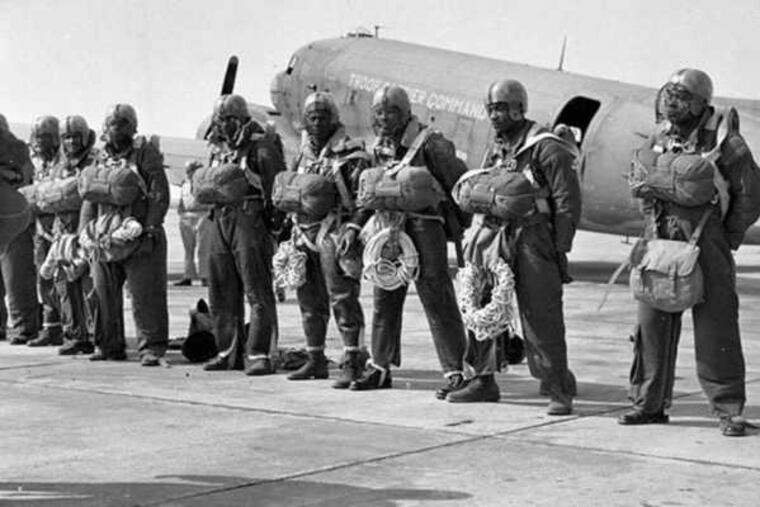Main Line, Pa., man killed on secret WW II mission is now getting his due
After decades of obsurity, Malvin L. Brown and other members of the nation's first all-black paratrooper unit are being honored with a historic marker.

Like the mission that would claim his life at age 24, the burial place of Malvin L. Brown was a mystery that outlived most of his survivors.
Brown was a paratrooper in a little-known unit dispatched on a top-secret World War II mission that had its roots in one of the great discoveries in the history of atmospheric science.
Seven decades later, and after a lengthy search, his tombstone finally was located in a heavily weeded cemetery outside Baltimore, and a plaque affixed to it two years ago.
Now the Main Line native and other members of his unit – the 555th Parachute Infantry Battalion, or Triple Nickles – will be honored June 3 with an official marker in Oregon. That's the state where a tragic accident took his life Aug. 6, 1945, the same day an atom bomb was dropped on Hiroshima.
For the Triple Nickles, the event on the grounds of the National Smokejumper Museum in Cave Junction, near the California border, will bring another measure of recognition. With the publication of books and public events, organizers say, interest in the group's history has experienced a revival analogous to the revived interest in the old Negro Leagues of professional baseball.
"It's really exciting," Annie Von Domitz, an official with the Oregon Travel Experience, the agency responsible for the state's historical markers, said Friday. "It will help people discover the stories."
"It's taken a long time," said Sharon Murchison, who helps run the Triple Nickles Association and whose husband, Joseph, is the association's president.
Similarly, so has the unraveling of the Malvin Brown story.
Members of Brown's unit and the allied National Smokejumpers Association had long wanted to put a marker on his grave – but didn't know where he was buried. After a 2010 Inquirer article mentioning Brown, Smokejumpers member Fred Donner contacted the paper seeking help in finding the gravesite, and the tomb eventually was found at Mount Calvary Cemetery.
According to the death certificate, Brown died of a skull fracture while parachuting into an Oregon forest during a top-secret "Operation Firefly" mission.
He left behind a wife and daughter. Three months after he died, his wife made a $50 payment on a $472.33 invoice from a Bryn Mawr funeral home.
But his family was told almost nothing about his death, recalled his niece Vernell Brown.
She had lived in a twin house in a working-class, integrated neighborhood in the Haverford section of Lower Merion Township with her parents, two sisters, and Malvin Brown, who was 9 years older.
She recalled him as a "very compassionate" young man, and no one was surprised when he signed up for the military. He did surprise everyone when he came home on leave from boot camp and informed his family that he was making history: He was becoming a paratrooper.
Typically, black servicemen were assigned to food service or transportation jobs, but under President Franklin D. Roosevelt, the Army created an all-black paratroop unit, the Triple Nickles, and Brown jumped at the opportunity.
"No one, including President Roosevelt, believed you could take a dishwasher and he could go through the four weeks of training that it took to become a paratrooper," the late Walter Morris said in an Inquirer interview.
U.S. commanding officers in Europe feared that the presence of black soldiers might stir racial tensions, and the unit was dispatched to join the Forest Service's smoke jumpers -- parachuting firefighters -- in the Northwest.
The Japanese were bombing the U.S. mainland with primitive intercontinental ballistic missiles – hot-air balloons, equipped with incendiary devices, riding wind currents that a Japanese genius, Wasaburo Ooishi, had discovered two decades earlier.
Ooishi published his findings, but they were ignored. Allied bombers discovered them the hard way when they reached higher altitudes during World War II and confronted headwinds that ate their fuel and blew their bombs off-target.
The currents became the highways for Japanese balloon bombs that were directed toward the Northwest with the aim of setting off raging forest fires and nationwide panic. For the most part successfully, U.S. intelligence did everything in its power to conceal the attacks from the public. The Triple Nickles were enlisted in Operation Firefly to aid U.S. Forest Service smoke jumpers.
Jet-stream winds evidently turned out to be far more chaotic than the Japanese thought, and the balloon-bomb campaign was mostly a dud. It failed to set off any significant fires, although a detonated balloon remnant did kill six people attending a Sunday school picnic in Oregon.
On his fatal jump in the Umpqua National Forest, no evidence suggests Brown was responding to a fire set off by a balloon bombs, and the Japanese campaign remained a closely guarded military secret.
"We didn't know any of that," Vernell Brown said. "They told us he was killed when he jumped into a tree. We knew he was fighting forest fires."
The Triple Nickles might have suffered collateral damage from those veils of secrecy, said Von Domitz, since few people knew of the unit's existence.
"We want to make sure people in Oregon know about it," she said.